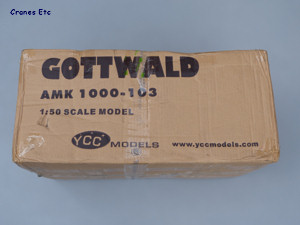 |
| The outer box.
|
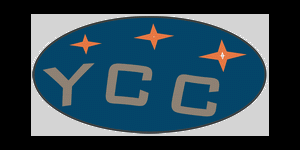 |
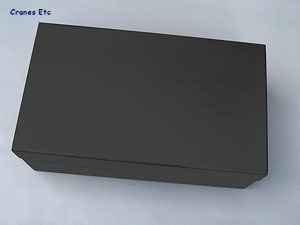 |
| Heavy presentation
box. |
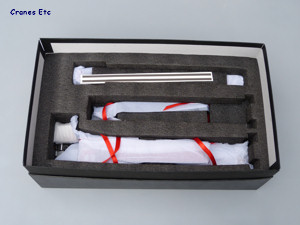 |
| Bottom layer contains
the vehicles and boom. |
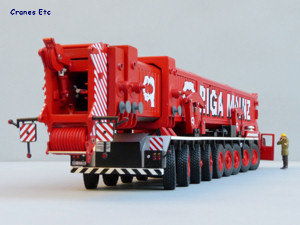 |
| Marker boards at
the rear. |
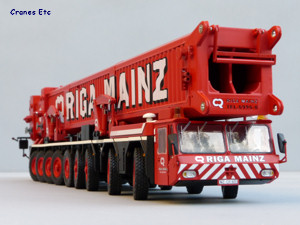 |
| Boom is massive
and heavy. |
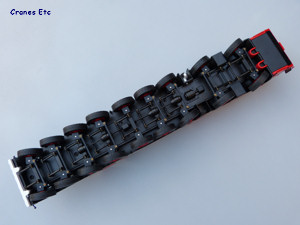 |
| The boom carrier
chassis is reasonably detailed. |
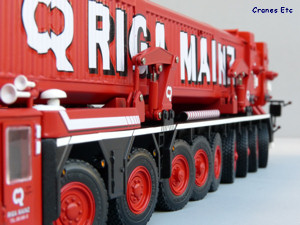 |
| Imposing poses
are possible. |
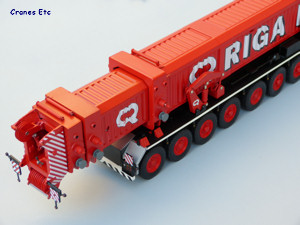 |
| The boom has to
be extended a little to accurately represent the loading
requirement of the carrier. The inner logo is imperfectly
rendered. |
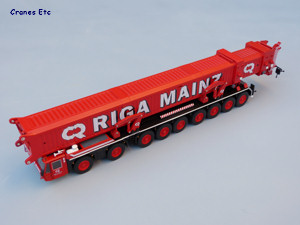 |
| The boom carrier
AMK 1000-93. |
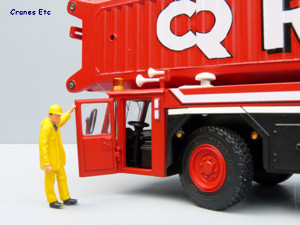 |
| Opening cab door.
|
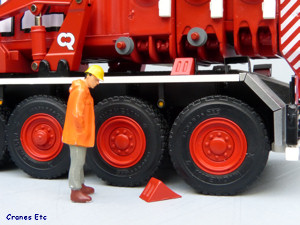 |
| Wheel chocks are
well made. |
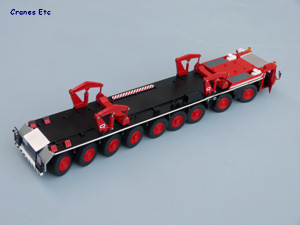 |
| Boom removed.
|
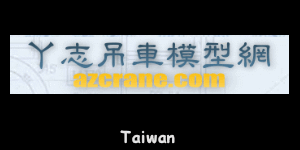 |
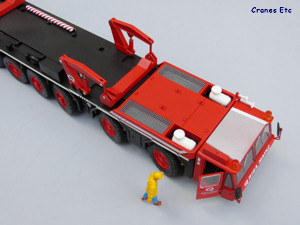 |
| Good detail behind
the cab. |
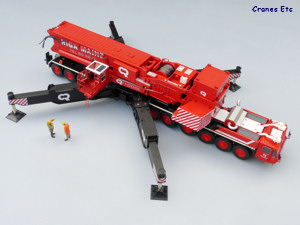 |
| Outriggers fixed,
waiting for the boom. |
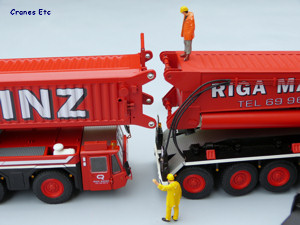 |
| Driving up the
boom to connect it. |
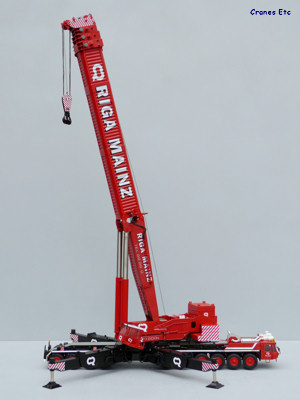 |
| Boom up and hook
on. |
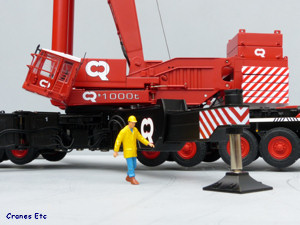 |
Outriggers can
hold the weight of the crane.
|
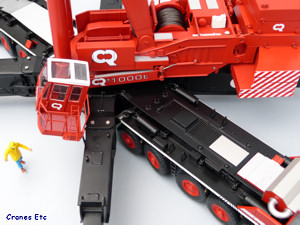 |
| Great details all
round. |
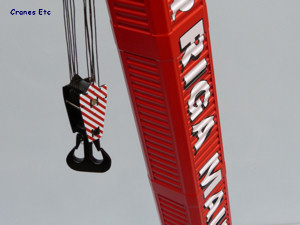 |
| Hook is excellent. |
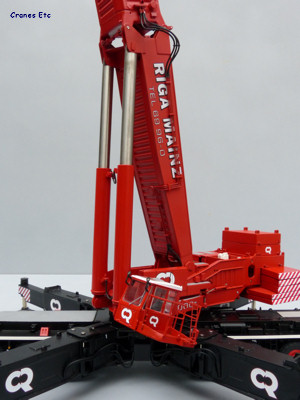 |
| Impressive boom
cylinders. |
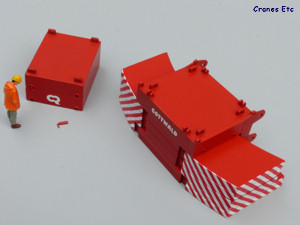 |
| Counterweights
and pin. |
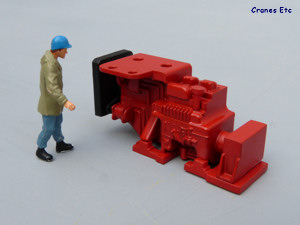 |
| Detailed engine
block from the crane. |
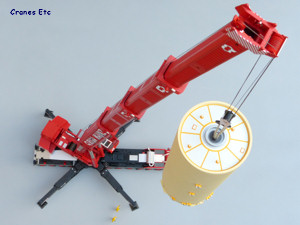 |
| Lifting a load
at height. |
|
The Gottwald AMK 1000 had a nominal
lifting capacity of 1000 tonnes and was for many years the
largest telescopic crane in the world. It was built
in the mid 1980s for Riga Mainz of Germany.
The crane was carried on a 10-axle carrier designated AMK
1000-103 and the boom was carried on a separate 9-axle transporter
designated AMK 1000-93.
Riga Mainz operated the crane for eight years and it was
then sold to Breuer of Germany where it worked for three
years. It then went to Taiwan and was operated by
Long Hook for five years. In 2004 ownership transferred
to Chisun.
This model is in the colours of Riga Mainz in a later version
of the livery.
Packaging
The model comes in a heavy outer cardboard carton which
has a foam layer inside which protects a coloured picture
box. Inside that is a heavy black presentation box
which contains the model and its many parts wrapped in tissue
and contained in stiff foam rubber.
The packaging is excellent but the model is heavy with
many small delicate parts and it is not surprising that
a few parts were loose in the box on the review model as
a result of the postal system. However these were easy
to glue back into place. One other very small part (a
hydraulic line connector on the boom) was missing. YCC recognises the risk to the delicate parts and a bag of various
spares is included in the box.
All this means that the model has to be handled with care
as any pressure on small parts whilst lifting it will inevitably
damage them.
A glossy brochure is included which has machine specifications
and information about the history of the real machine.
High quality photos of the various liveries modelled are
included, and straightforward graphics show the main aspects
of the assembly. However there is no guidance or diagram
for reeving the three hooks supplied. Also included
is a Perspex block which contains a laser etched facsimile
of the crane and boom carrier in 3D. It is also engraved
with a unique model number and it is very superior to any
normal numbered collector card.
Overall the packaging is of the highest quality notwithstanding
that there were some broken small parts on arrival which
are more likely due to the packing process than the
packaging.
Assembly is easy enough in principle, but was not without
some problems on the review model. The winch drum
was extremely stiff and took some effort to free up by applying
'WD 40' and oil to the bearings and rubbing surfaces.
One of the counterweight plates had holes which did not
line up with the plate above so the connecting pins would
not fit. This was rectified by grinding off the edge
of four pins to produce a special set that would fit.
The shape of the boom with its corrugations provides a particular
challenge to apply the graphics, and a couple of the logos
were not perfect. Again YCC has recognised the likelihood
of the issue and provides spare graphics transfers with
the model to enable the owner to make repairs. The
boom corners of the inner sections are also likely to be
rubbed by extending and retracting the boom and more spare
transfers are provided for this.
Detail
The boom carrier and crane carrier share a common level
of detail. Underneath, the chassis has reasonable
detail with the main transmission components modelled although
it may have been difficult for YCC to get the information
to achieve high accuracy. The wheels are excellent
with detailed hubs (which are different on the driven axles)
and tyres which have Michelin and the tyre details in the
sidewalls.
The driving cabs set a very high standard and they look
convincing, and the cab door hinges are a reasonable modelling
compromise in terms of size. The wipers and mirrors
are finely crafted, and the lights and number plates look
great. Interior details are fine. Both carriers
have tiny and delicate reflectors between the wheels.
At the rear the light clusters are also excellent and the
warning notices and number plates add authenticity.
The carrier decks have a high level of detail within the
casting, and small metal wheel chocks fit into special holders.
The boom carrier has two lift assemblies which are modelled
well and only perhaps the silver rivets would have looked
better painted red. A red and white tow bar is provided.
It does not have any connections and just rests on the carrier
deck.
The crane carrier has the heavy turntable support modelled
well with hydraulic cabinets and motors.
The crane body structure looks very strong and the connection
points for the boom and counterweight have the hydraulic
pinning system modelled. One amazing aspect is the
degree of modelling detail in the area of the winch drum.
much of it cannot be seen in normal view and is only properly
visible from underneath. This includes a metal engine
block which is a fine casting.
The boom foot is lifted by two massive hydraulic cylinders
and these are all metal components. There is excellent
hydraulic pipe detailing up the boom foot to the main boom
connection point.
The operator's cab is finely modelled. Interior detail
is very good and the work platform and handrails are metal
and fine gauge. Work lights and an aerial add to the
detail.
Four massive outrigger beams support the crane and these
are made of metal and are heavy. Again there is fine
detailing with hydraulic pipes and lines. The pistons
have a smooth external appearance so look authentic.
Heavy metal pads fix to the pistons.
The counterweight consists of a number of separate plates
and these interlock together and are secured by tiny locking
pins which look great.
The four stage telescopic boom is a very heavy piece of
modelling. The structure is great with the corrugations
in the walls modelled well. The decoration looks great,
noting the imperfections mentioned earlier. Detail
at the boom head is great with a hydraulically adjustable
rear pulley block and anemometer. The pulleys are
metal and very free rolling. As an additional detail
two marker boards are supplied which fit into the boom head
for when it is resting on the boom transporter.
Three different sizes of hook are supplied. They are
metal and detailed with excellent pulleys.
Features
The carriers have fully sprung suspension on each axle and
each steerable axle steers. The wheel spacing is tight
so they need to be carefully set to avoid touching when
they are steered.
The cab doors open widely.
The boom lifters on the boom carrier can be raised and lowered
but the boom is way too heavy for them to hold it up off
the deck so dummy 'boom cushions' are supplied which look
discrete and enable the boom to be posed at the correct
height on the boom carrier for offering up to the crane
for connection.
The outriggers fit to the crane using magnetic buttons which
hold them well. They are extendible and the mechanism
is very smooth. The pistons can be screwed down and
the pads are magnetic which is a great feature as it makes
moving the model easy as the pads remain stuck on.
The outriggers can support the heavy weight of the model.
The operator's cab can be rotated out from transport
position, and also tilts. However on the review
model this was initially fairly loose so that the cab
drooped down. This was fixed by removing the
vertical pin and tightening the retaining screw.
The aerial folds down for transport and the metal access
ladder can be raised and lowered. The cab door
opens and closes.
The boom lifting cylinders are perfectly smooth in operation
as they are beautifully engineered. They are locked at
any extension by tightening a discrete grub screw at the
top of each cylinder jacket using the special tool supplied.
These are the best boom cylinders seen on any crane model
reviewed by Cranes Etc as at the time of the review.
The connecting pins for joining the boom and the counterweight
to the crane are contained within the hydraulic pin holders
and they slide into place just like the real thing.
The telescopic boom extensions pull out smoothly but they
are so heavy that if they are not pulled out straight it
is easy for friction on the edges to scrape the paint hence
why YCC include some paint transfers for touch up if needed.
The sections have conventional locks to prevent the sections
being accidently pulled out to far. The real boom
locking pin mechanism has been modelled and this is used
to lock the telescope sections at intermediate or full extension.
The model rotates very smoothly even though the weight and
forces are high.
The boom also has working rollers to guide the winch line,
and the anemometer at the end can be rotated.
The winch drive is accessed by removing a small magnetic
cover and then a special tool can be inserted and powered
by an electric screwdriver to raise and lower the hook.
There is plenty of friction in the mechanism to hold any
load on the hook, but a more positive action push brake
would have been better.
The hook blocks have rotating hooks and working spring loaded
safety latches.
Another display option is provided as the front and rear
parts of the crane carrier vehicle can be disconnected and
leave the crane standing on a pedestal formed of the outriggers.
Quality
The model is very well made and looks great, and the teething
problems associated with the review model being an early
production version do not detract from the finally completed
model.
It has a very high metal content and is very heavy, and
the engineering is generally very good and excellent in
places.
The paintwork and graphics are excellent other than for
the defects stated earlier.
Price
This is an expensive model in anyone's money but it does
by an excellent model of an exceptional crane which will
be made in relatively small numbers.
Overall
YCC have produced another excellent model which will be
sought after by collectors that can afford it. Hopefully
the few problems encountered on the review model will be
resolved for later batches, but for the discerning collector
the Gottwald AMK 1000 will be an essential part of a serious
collection. By any measure it is an outstanding model.
Footnotes
The model first appeared as a prototype at the Nuremberg
Toy Fair in February 2011. Shipments began in January
2012. Five versions were produced and the first run
production quantities are:
Riga Mainz (history) - 90 models
Riga Mainz (modern) - 200 models
Breuer - 200 models
Long Hook - 80 models
Chi Sun - 55 models
This model was awarded Model of the Year for 2012 in the
Cranes Etc Review of the Year.
|
| |
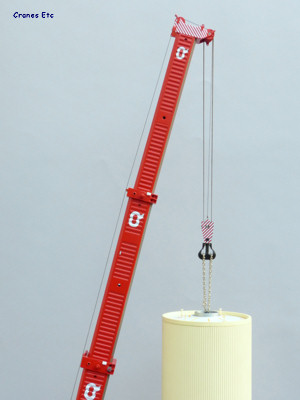 |
| Telescopes at full extension
to the 100% boom locks. |
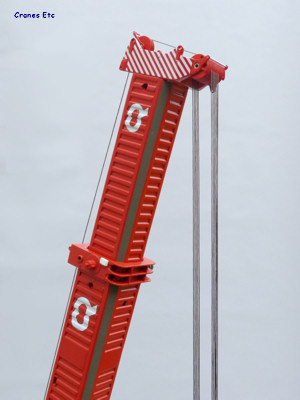 |
| Boom section pinned at an
intermediate position. |
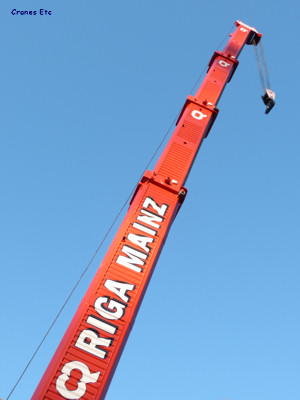 |
| Is it real or is it a model? |
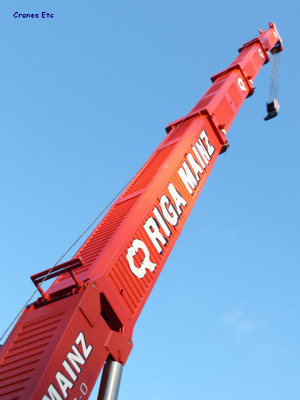 |
| Working rollers guide the
winch rope. |
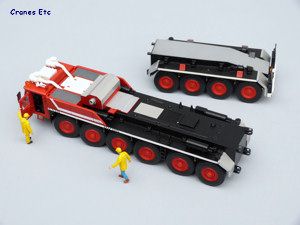 |
| Crane carrier transport
detached. |
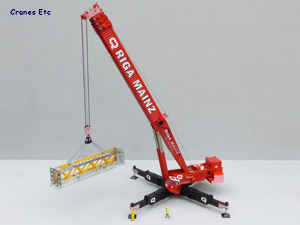 |
| Lifting on the pedestal. |
 |
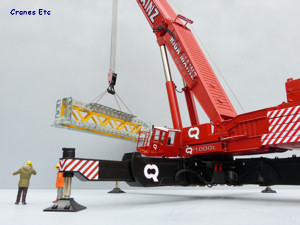 |
| Strong outriggers take the
load. |
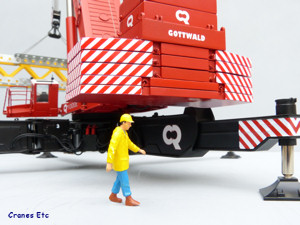 |
| It just looks great. |
|
|
|
|
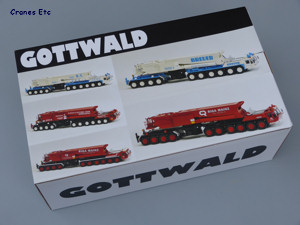 |
| Colourful picture
box. |
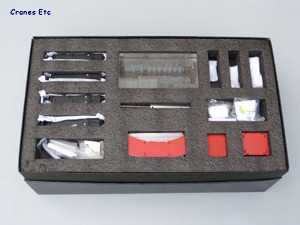 |
| Top layer has the
outriggers, counterweight, hooks and small parts. |
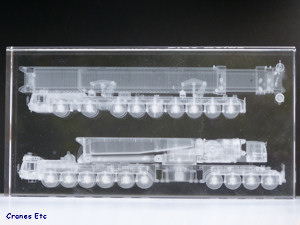 |
| Laser etched block
also has a unique number engraved on the edge. |
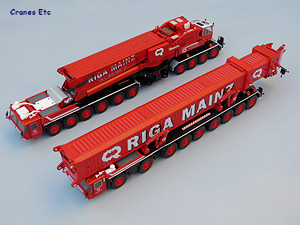 |
| Crane and boom
carrier. |
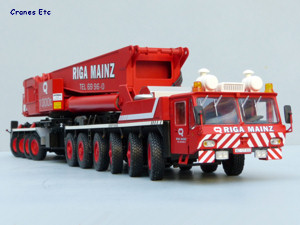 |
| Crane carrier.
|
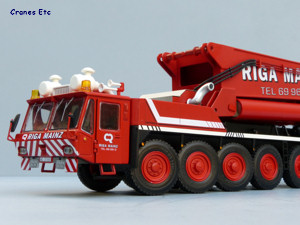 |
| Excellent cab detail.
|
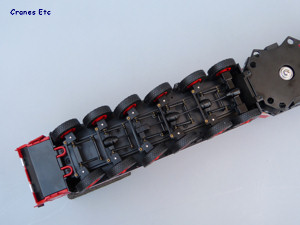 |
| Under the crane
carrier. |
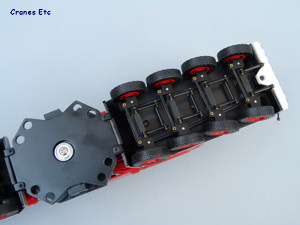 |
| Each axle steers.
|
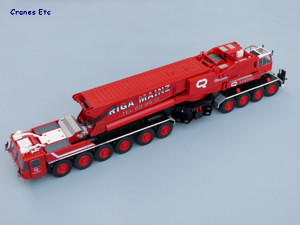 |
| The crane carrier
AMK 1000-103. |
 |
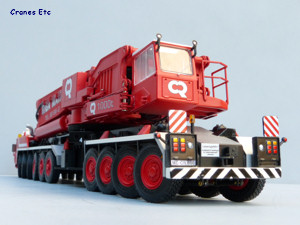 |
| Great detail at
the rear. |
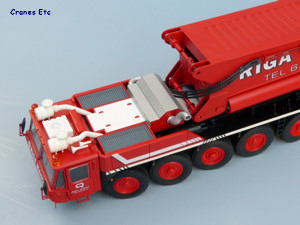 |
| Equipment on the
cab roof. |
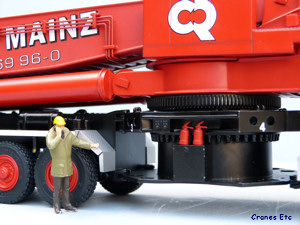 |
| The pinion drives
to the toothed ring are missing details. |
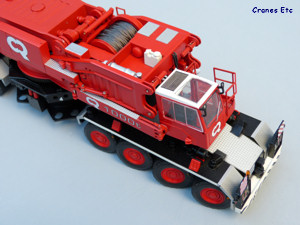 |
| Detail behind the
winch is very good. |
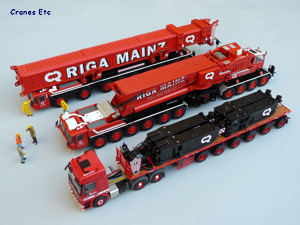 |
| The
Riga Mainz
ballast carrier
is from the wrong era which is why the Cranes Etc team are
arguing. |
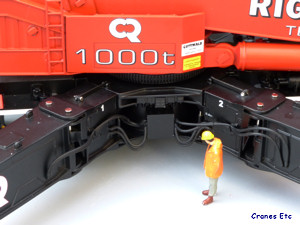 |
| Excellent hydraulics
from the outriggers. |
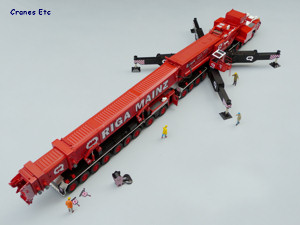 |
| The boom being
connected. |
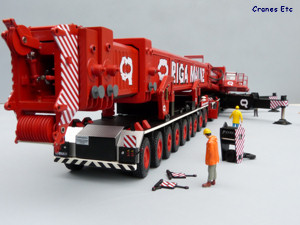 |
| An impressive pose
is possible - if you have the space. |
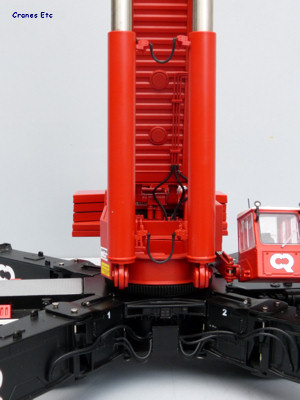 |
| Great detailing
|
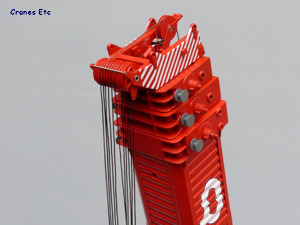 |
| Boom top looks
impressive. |
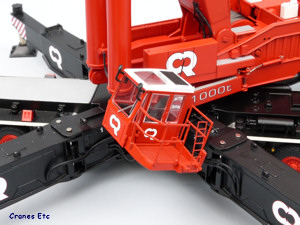 |
| Detailed cab. |
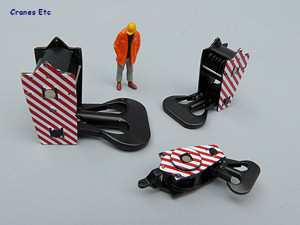 |
| Three hooks are
supplied. |
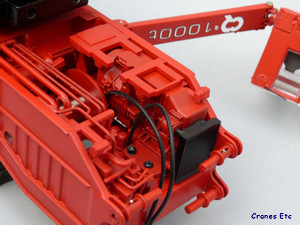 |
| Underneath the
crane body reveals exceptional detail. |
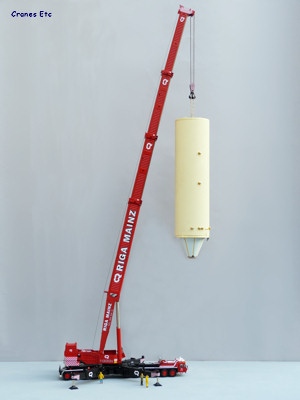 |
| Lifting a
fermentation
tank with ease. |
|

